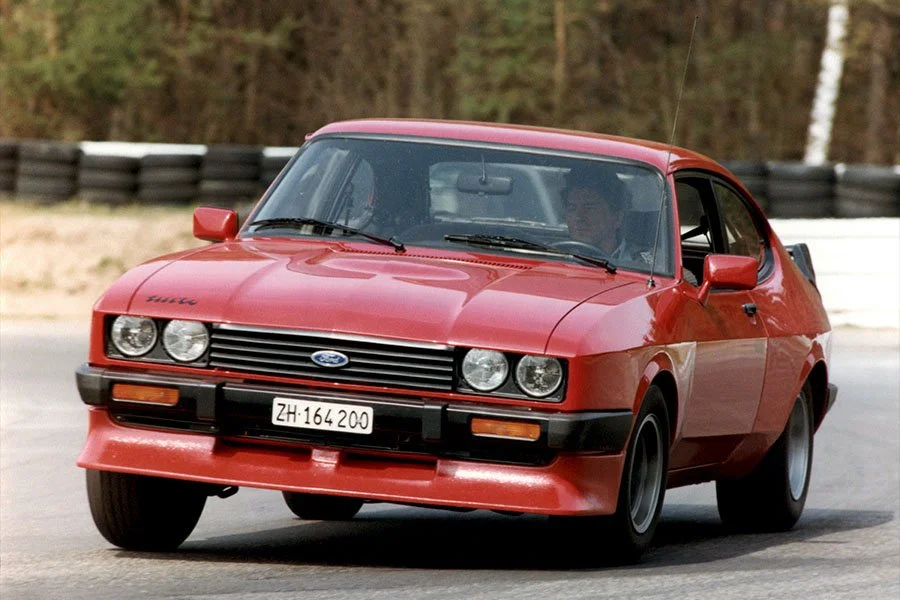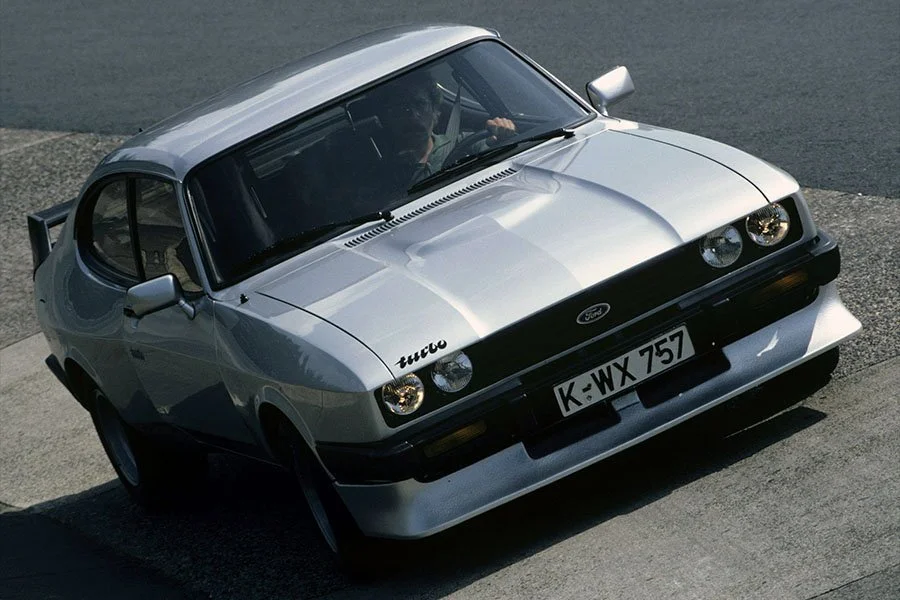Guide: Homage to Zakspeed - a Historical & Technical Appraisal of the Ford Capri Mk3 Werks Turbo
/BACKGROUND
In light of the Mustang’s massive commercial success, Ford of Europe decided to create a scaled down version better suited to the Old World. The resultant Capri was launched at the Brussels Motor Show in January 1969 and by late 1977 Ford had managed to sell around 2.5m copies across the Mk1 and Mk2 platforms.
In addition to having proven itself a real money spinner, the Capri also served as the basis for a world-beating Group 2 Touring Car. Using the fabled RS2600, Ford won six out of eight races in the 1971 European Touring Car Championship (ETCC), claimed the premier Division 3 Manufacturers’ title and Capri man Dieter Glemser was crowned Drivers champion.
This was followed up by an even more impressive 1972 campaign when the RS2600 claimed eight wins from nine ETCC events which saw Ford claim back-to-back Manufacturers’ titles and secured Jochen Mass the Drivers’ championship. That year, the Capri RS2600 also finished first and second in the Touring class at the Le Mans 24 Hours. With nine wins from ten races, Ford’s Hans-Joachim Stuck won the inaugural Deutsche Rennsport Meisterschaft (DRM).
Having been de-throned by BMW’s big budget CSL in 1973, Ford hit back with the RS3100 for 1974. However, as a consequence of an Oil Crisis caused by war in the Middle East, the company ultimately only ran a limited campaign but still won half the races they contested with the 3.4-litre Cosworth-engined Capris which now produced over 400bhp.
As economic conditions had failed to improve by 1975, Ford did not play an official role in that year’s ETCC or DRM and it wasn’t until 1978 that the Capri made a return to top flight motor racing by which time the face-lifted Mk3 had gone into production following its launch at the Geneva Motor Show in March 1978.
What emerged for that season was a factory-backed Group 5 version of the Mk3 Capri built by Zakspeed in Niederzissen to contest the DRM. At the time, Group 5 regulations enabled manufacturers with cars that had been homologated in Groups 1 through 4 to create radically modified machinery that only bore a passing resemblance to the donor models upon which they were based.
Having started out as a Division 2 class challenger in the 1978 DRM, the turbocharged Zakspeed Capris ultimately took the fight to Porsche’s mighty 935 in the Division 1 class. Most famously, Zakspeed won the 1981 DRM championship thanks to their Division 2 driver, Klaus Ludwig. Meanwhile, Ludwig’s team-mate Manfred Winkelhock placed third in the standings with his Division 1 class machine just five points behind Bob Wollek’s Kremer 935 despite a superior record of six outright wins to Wollek’s three.
In order to create a link between its showroom offerings and the wild forced induction Zakspeed racing cars which it had bankrolled at not insignificant expense, over the winter of 1980-1981 Ford’s works Motorsport department in Cologne developed a turbocharged Mk3 Capri which ended the long wait for a successor to those iconic RS-badged variants manufactured between 1970 and ‘74.
Based on the normally aspirated and fuel-injected 160bhp Capri 2.8i launched in February 1981, what was dubbed the Werks Turbo by Ford’s German Rallye Sport dealers mixed several trick new parts with existing items from the existing RS parts catalogue. Offered exclusively in left-hand drive, production started at the Cologne Motorsport department in July 1981 and the Werks Turbo was given an official presentation a few weeks later at September’s Frankfurt Motor Show.
CHASSIS
Each Werks Turbo started life as a standard Mk3 Capri steel monocoque bodyshell with 2565mm wheelbase. This was then modified to incorporate a battery tray on the left as opposed to right-hand side of the engine bay in order to accommodate the turbo hardware.
A 58-litre fuel tank mounted under the trunk floor was carried over from the standard car.
Suspension was via MacPherson struts with lower control arms up front and a leaf sprung axle with trailing arms at the rear. For the Werks Turbo, the Motorsport department in Cologne added reinforced wishbones, shorter, stiffer springs and gas-filled Bilstein dampers, an anti-dive kit, a thicker front anti-roll bar and firmer bushes. Ride height was dropped by 25mm compared to a regular 2.8i.
The twin circuit brake system was identical to the Capri 2.8i up to the brake master cylinder from which point the lines to the rear axle were routed on separate sides to a pressure reducer mounted on the axle. Internally vented front discs had a 262mm diameter. Reinforced rear drums had a 229mm diameter.
Four-spoke 6.5 x 13-inch alloy wheels were imported from the Rally Sport catalogue and shod with 205/60 VR13 Pirelli tyres.
The existing power-assisted steering system was modified to incorporate a shorter steering column that was necessary owing to the modified engine installation.
ENGINE / TRANSMISSION
In the engine bay was an all-iron 60° V6 with overhead valves actuated via tappets, pushrods and rocker arms.
Each unit started out as a normally aspirated carburettor-equipped unit from the Granada. After a rigorous programme of modifications, they emerged from the Cologne Motorsport department with a comprehensive list of upgrades. This included pistons with nickel-plated rings, a Tuftrided crankshaft, electronic ignition, a milled cylinder head surface, heavy duty head gaskets, a heavy duty oil pump, a supplementary oil cooler, Bosch K-Jetronic fuel-injection, a single Garrett T04 B50 turbo (which ran at up to 0.4 bar) and a sports exhaust system.
Displacement was unchanged at 2792cc thanks to a bore and stroke of 93mm and 68.5mm respectively. A 9.2:1 compression ratio was similarly carried over which resulted in peak output figures of 190bhp at 5500rpm and 198lb-ft at 4500rpm.
For comparison, the Capri 2.8i produced 160bhp at 5700rpm and 162lb-ft at 4200rpm.
Transmission was through a four-speed manual gearbox with single-plate clutch and open differential.
BODYWORK
For the Mk3 Capri, Ford had most notably redesigned the front end to incorporate a hood that was pulled down over the tops of the two circular headlights per side and fitted new tail light clusters and bumpers.
As you would expect from a car that was priced at almost the same level as Porsche’s forced induction 924, the Capri Turbo came with a number of distinctive tweaks that helped it stand out from the rest of the Capri range.
To accommodate the wider wheels and tyres, flared X-Pack fenders were installed.
Under the front bumper, Ford added a fibreglass body coloured Zakspeed chin spoiler. To equalise downforce, a moulded black polyurethane dual plane rear spoiler was mounted at the trailing edge of the lift-up tailgate.
Turbo decals were added to the hood, doors and tailgate fascia.
Aside from the aforementioned spoilers, body panels were fashioned exclusively from steel.
A rear windscreen wiper was fitted as standard.
INTERIOR
As had been the case with the exterior, Ford made a series of cosmetic updates to the Mk3 Capri’s cockpit architecture that focused on a redesigned dash assembly with revised instrumentation and new seats.
For the Werks Turbo, the front seats were switched out for a pair of two-piece Recaro buckets trimmed in crushed Shark Grey velour fabric to match the individually contoured rear seats and door panel inlays.
The normal three-spoke steering wheel was exchanged for a small diameter RS-branded leather-rimmed four-spoke item. The gear gaiter was also now leather.
As per the 2.8i, the Turbo featured a six-gauge instrument binnacle, outboard of which was a fresh air blower to match the one located on the passenger side of the dash.
Directly behind the steering wheel were large read outs for engine speed (7000rpm) and road speed (220kmh). Flanking these were stacked smaller dials for battery voltage, oil pressure, water temperature and fuel. Located off to the right (all Capri Turbos were left-hand drive) was the audio system housing, ventilation control panel and a bank of four switches. A clock was positioned ahead of the gear lever.
Although an audio system cost extra, each car departed Cologne with four speakers already installed.
Split fold-down rear seats ensured luggage access and capacity via the lift-up tailgate was excellent.
OPTIONS
Ford offered the Capri Turbo in a choice of four colours. Diamond White was the standard livery while Silver, Red or Pine Green were available at extra cost.
Other optional extras included 7 or 7.5-inch wide wheels, a limited slip differential with 75% locking factor, electric windows, tinted glass and an audio system.
WEIGHT / PERFORMANCE
As a consequence of its wide-arched body and additional engine plumbing, the Turbo weighed in 35kg heavier than a standard 2.8i Capri (1225kg as opposed to 1190kg).
However, top speed was now 134mph (up from 127mph) and the 0-62mph time was cut from 7.9 to 6.7 seconds.
END OF PRODUCTION
Capri Turbo production ran from July 1981 until September 1982.
During this time it is understood that 155 units were completed.
Text copyright: Supercar Nostalgia
Photo copyright: Ford - https://www.ford.com




































